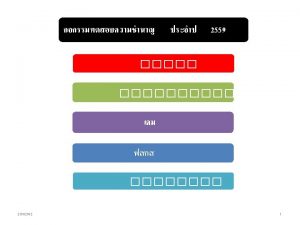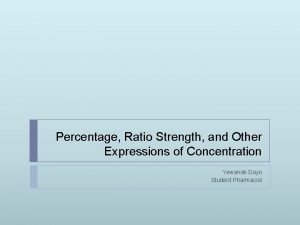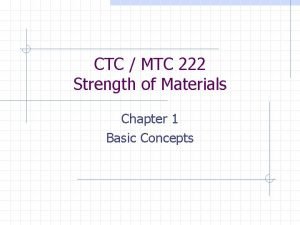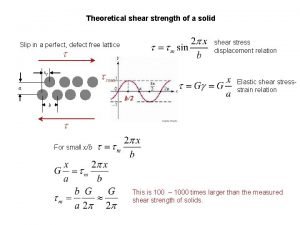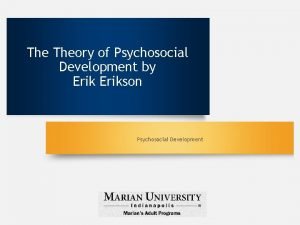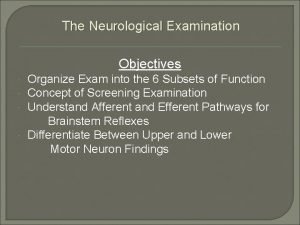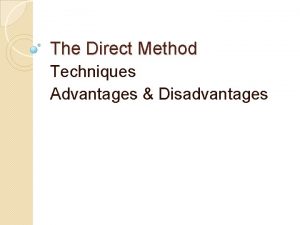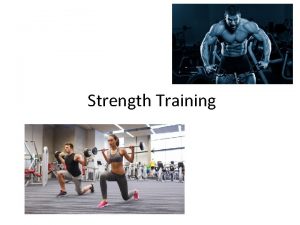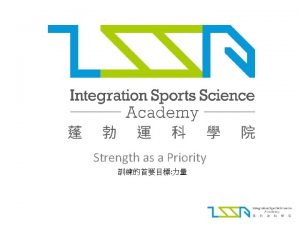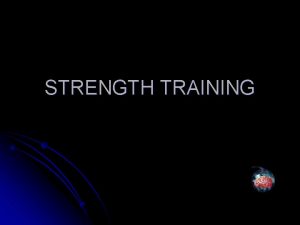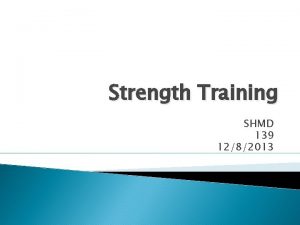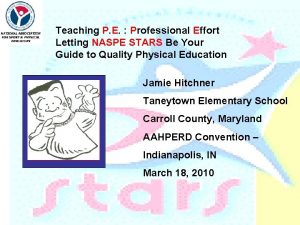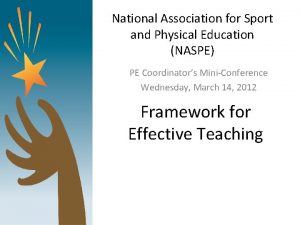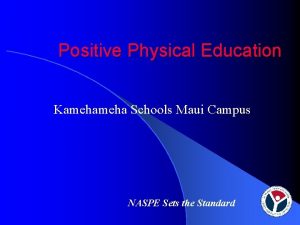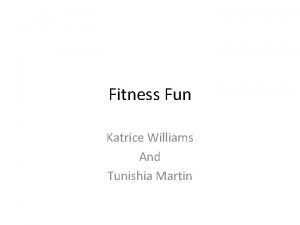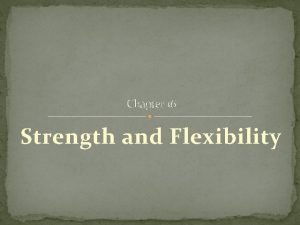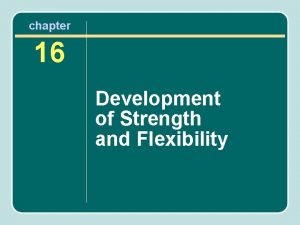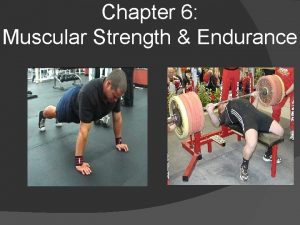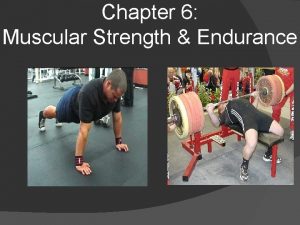Chapter 9 Strength NASPE Standards 9 1 Strength





















- Slides: 21

Chapter 9 – Strength NASPE Standards: 9. 1 – Strength Basics 9. 2 – Improving Your Strength

9. 1 – Strength Basics 3 Objectives: 1. Describe health and wellness benefits of strength. 2. Describe some myths about strength and tell why they are wrong. 3. Explain why preteens and teens must take special care when strength training. 1

Health and Wellness Benefits Strength – the amount of force a muscle can exert. Regularly use of muscles = strong muscles. Non use of muscles = weak muscles. Benefits of strength: • Work and play with less fatigue • Prevents some health problems • Strengthens bones • Gives you a firm appearance • Prevents back ache • Muscles burn more calories • Helps you maintain good posture 2

Strength for Preteen and Teens Between the ages of 11 and 18 the bones are rapidly growing at the growth centers. By age 19 to 21, the soft cartilage turns into bone. • Growth centers are soft cartilage and can easily be injured. • Lifting heavy weights can cause the part of the bone above the growth center to slide past the part of the bone below it. • The result could be a broken bone or damage growth center. • Once the growth center has turned to bone it is no longer as easily injured.

Anabolic Steroids - synthetic drugs that resemble the male hormone testosterone. Legal: • Prescribed by a doctor for use in certain diseases. Illegal: • Obtained without a doctors prescription. Anabolic steroid use is prohibited by the U. S. Olympic Committee and most other athletic associations. Anabolic steroids can be detected in the blood and urine. Anabolic steroids are extremely dangerous: • • Damage growth centers of bones Hair loss/baldness Severe acne Deepening voice, dark facial hair growth, reduced breast in women Reduced sperm count, shrunken testicles, enlarged breast in males Stunted growth in teens Increased risk of cancer Irritability, mood swings, extreme anger, violence 4

Myths and Misconceptions • Only males need to be concerned about their strength. MYTH – Both males and females need strength to be healthy, to avoid injury, to look good, and save themselves in and emergency. • Women fear that strength training will cause their bodies to look masculine. MISCONCEPTION – Hormones in women's bodies prevent them from developing large muscles even when they exercise regularly. • Strength training will cause me to be muscle-bound. MISCONCEPTION – Improper strength training causes muscle boundness, or inflexibility, not strength training. (Ex. Failure to move a joint through a full range of motion, or vigorously exercising some muscles while ignoring others. ) 5

9. 1 - Check for Understanding 1. The amount of force a muscle can exert is called __________? 2. What is the ‘growth center’ in bones? When is it most easily injured? What happens to the growth center around the age of 19 -21? 3. What are the effects of anabolic steroids? 4. How does strength contribute to your health?

9. 2 Improving Your Strength 3 Objectives: 1. Name and describe the types of exercises you can do to improve your strength. 2. Describe progressive resistance exercise and why it is important. 3. List the guidelines for resistance training. 1

The Physical Activity Pyramid and Strength exercises involve the exertion of near maximal muscular force against a resistance. 2

Strength Exercises Isometric Exercises (Static Exercises) – muscles contract but the body parts do not move. Isotonic Exercises (Dynamic Exercises) – muscles contract and body parts move. There are several types of isotonic exercises for strength training. • Isokinetic • Plyometric • Calisthenics • Weight Training 3

Isokinetic Exercises are done with special apparatus such as the Exergenie or the Cybex. These devises control the speed of movement of a body part so it remains constant, and provides a constant force throughout the range of motion. These are often used in rehabilitation

Plyometrics used by athletes to train for the development of power. Plyometrics involve a quick stretch followed by a strong muscle contraction. (Ex. To develop power in the legs – a series of hops or jumps. ) Not usually recommended for preteens and teens because they can place a great deal of stress on the tendons. 5

Calisthenics are done using your own body weight as resistance. (Ex. push-ups, pull-ups, trunk curls, squats. ) Weight/Resistance Training involves the lifting of weights to build strength or endurance. (Ex. Free weights, weight machines, home made weights. ) 6

Types of Weight Training • Weight Training – non competitive, used to improve muscular strength and endurance. Usually done for 3– 25 reps, lifting 50%80% of 1 RM. • Circuit Weight Training – the same as weight training, except it is usually used to develop aerobic endurance as well as strength and endurance. • Weight Lifting – an Olympic sport using free weights in which a maximum load is lifted. (Ex. The snatch and the clean and jerk. ) • Power Lifting – competitive sport using free weights, where athletes try to make one maximal lift. (Ex. The bench press, squat, and deadlift. ) • Body Building – can be done for competition. Athletes are primarily concerned about the appearance of their bodies. Is done using more repetitions than weight and power lifters use. 7

Progressive Resistance Training • When you exercise with weights or other resistance to improve strength, your muscles get stronger. • As you get stronger you find the exercise easy. • You will not get any stronger unless you increase the amount of resistance you use. • The gradual increase of resistance used in strength training is called progressive resistance exercise or PRE. • PRE is the best way to develop strength. 8

Fitness Principles and Strength Principal of Overload – in order to get stronger, muscles must work against a greater load than they are use to. To increase strength muscles must be contracted to at least 60% of their maximum. • If muscles are worked against less than normal resistance they will weaken. • If muscles are always worked against the same amount of resistance they will maintain the same strength, because over time muscles adapt to the stress. 9

Fitness Principles and Strength continued… Principle of Progression - overload gradually (increase the load over a period of time). • To progress you must continue increasing the resistance until you reach your goal strength. • You can injure yourself if you try to lift too much weight too soon. • Lifting too much weight will not result in as much strength gain as would occur if you progressed gradually. • Progressive resistance exercise is based on the principles of overload and progression. Principle of Specificity – exercise of specific muscles you want to develop. • If you want to strengthen the muscles in the back of your thighs, you must overload that specific group of muscles (hamstrings). • The principle of specificity also means you should do strength exercises that resemble the movement you want to use. 10

The Fit Formula and Strength Isotonic Isometric • F – 2 -3 non-consecutive days a week. • I – Teens: 60 -75% of 1 RM for 7 -10 reps. Adults: 75 -90% of 1 RM for 4 -8 reps. • T – Teens: 7 -10 reps per set for 3 sets. Adults: 4 -8 reps per set for 3 sets. • F – Every other day and at least 2 -3 days a week. • I – Contract the muscles as tightly as possible for the required length of time. • T – Hold the contraction for 7 -10 seconds. Rest 30 seconds. This is one set. Do two more sets. 11

The stronger you are the more weight you need to lift to overload the muscles and develop strength. You should not do strength training on consecutive days – muscles need time to recover and grow.

Resistance Training Guidelines • Do not hold your breath while lifting, this can cause you to black out. Exhale on the lift/Inhale on the return. • ALWAYS use a spotter when using free weights. • Avoid overhead lifts with free weights. ’ • Learn and Use proper form. • Avoid fast, sudden power moves. Use sensible safe, slow, non-explosive movements. • NEVER use weight carelessly. • Concentrate on technique. • Use weight you can lift 7 -10 reps. Your muscles may be strong enough to lift more, but your bones are not. • Never compete when strength training. • Also use forms other than weights when strength training, such as calisthenics, elastic bands, or isometrics. 13

Check for Understanding 1. Muscles shorten or lengthen as they contract and cause body parts to move in _____ exercise? 2. How is the principle of overload applied in strength training? 3. How is the principle of progression applied in strength training? 4. How is the principle of specificity applied in strength training? 5. 1 RM represents what?
 Isometric exercise strengthens muscles without __________.
Isometric exercise strengthens muscles without __________. Naspe standards
Naspe standards Naspe exam
Naspe exam Steel bar
Steel bar Pharmaceutical calculations percentage strength
Pharmaceutical calculations percentage strength Darrow's solution composition
Darrow's solution composition What is the percentage strength of 1:1000
What is the percentage strength of 1:1000 Hard customer defined standards
Hard customer defined standards Strength of materials chapter 1
Strength of materials chapter 1 Intermediate accounting chapter 1
Intermediate accounting chapter 1 You are my strength when i am weak
You are my strength when i am weak Differentiate muscular strength from muscular endurance
Differentiate muscular strength from muscular endurance Demi size starbucks
Demi size starbucks Hilda taba 1962 model
Hilda taba 1962 model Structural strength and stability
Structural strength and stability Theoretical shear strength
Theoretical shear strength Ego strength erikson
Ego strength erikson Analisi swot chanel
Analisi swot chanel Weakness of utilitarianism
Weakness of utilitarianism Neuro exam strength
Neuro exam strength Neuro exam strength
Neuro exam strength Demerits of direct method
Demerits of direct method



